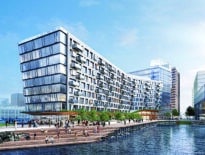
Lendlease transformed an abandoned industrial waterfront into a new living shoreline that acts as a natural buffer for its Clippership Wharf development in East Boston. Photo courtesy of Lendlease
I recently had the great privilege of sitting on a panel sponsored by A Better City to help provide insights from the private sector into one of the great challenges facing the next mayor of Boston: addressing the issue of resiliency in the face of rising sea levels and climate change.
My fellow panelists and I explored issues ranging from the pragmatic to the aspirational, touching on equity, economics and the difficulties of the regulatory process. As a developer, we at Lendlease encounter and address all of these issues whether by public mandate, economic self-interest or our corporate values. Being part of a forward-thinking real estate group with operating segments in development, construction and investments, we have a significant role to play to lead the industry with our sustainability commitments.
While developers are almost universally viewed with suspicion, we are an integral part of the effort to deliver solutions for the pressing issues of climate change and equity in the communities we revitalize.
Valuable Asset, Vulnerable Point
For many, Boston’s waterfront is one of its greatest attributes, serving as a reminder of the city’s rich history as a bustling trade port as well as a picturesque venue for recreation. As we’ve seen in recent years, however, outdated infrastructure and rising sea levels make Boston particularly vulnerable to climate events. With Climate Ready Boston, the administration of former mayor Marty Walsh made great strides in addressing the understanding of Boston’s vulnerability to sea level rise.
By identifying areas of critical concern and suggesting strategies to combat the inevitable encroachment into our communities, the city has taken a valuable first step. Now, it’s time to act on that initiative and to proactively protect our vulnerable communities. This should be a top priority for the next mayor of Boston.
To ensure new development projects in Boston stand up to the rigors of climate change, it is crucial for policymakers to focus on outcomes rather than regulatory restrictions. Too often, regulations focus on what landowners can’t do, rather than allowing innovation and creativity. A reliance on standards, rather than prescriptive and outdated strategies, might allow developers the latitude to invent new, cost-effective and viable solutions.
For instance, the tacit policy prohibiting the creation of new land in Boston Harbor creates a natural impediment to innovation. Boston has a long history of land-making, having filled in the harbor over the last two centuries. To disallow this practice now may be the single greatest impediment to realizing common sense solutions to address resiliency.
Nature-Based Alternatives to Seawalls
The trailblazing design study of Coastal Resilience Solutions for East Boston and Charlestown commissioned by the Walsh administration highlights the opportunities that a modest amount of new land creation can afford, recommending features such as salt marshes, elevated walkways and even swimming pools built out into the harbor as buffers against sea level rise.
At Clippership Wharf in East Boston, we created a “living shoreline” within the boundaries of our site, the first of its kind in Boston’s inner harbor. Salvaging granite blocks from the site’s previous uses, we incorporated terraced sections of natural plantings and salt marshes that serve as habitats for wildlife, wave dissipating features during storm events and natural buffers that can evolve as sea level rises.
This kind of solution, anticipated by the city’s coastal resilience study, could be replicated along the East Boston waterfront, and elsewhere, to not only protect the community from sea level rise, but expand waterfront access and increase the harbor’s biodiversity. Current regulations, coupled with physical limitations of many waterfront sites, make it extremely challenging for developers to incorporate similar features into their waterfront developments, leading many projects to instead erect more traditional, hard solutions like seawalls.
Nature-based solutions, especially on new land, offer a lot of promise and may provide a viable alternative to hard solutions or, worse yet, “coastal retreat.” While regulations are well-intentioned, the morass of public agencies and often conflicting guidance needs to give way to the common goal of meeting ambitious standards for shoreline protection.
It is also important to resist adding new, more onerous, regulations to specifically address climate change. New wetlands ordinances and zoning changes may be appropriate regulatory measures, but they must not stifle innovation, or more importantly, common-sense solutions. One answer for Boston’s next mayor could be to appoint a city advocate or ombudsman to help developers navigate the regulatory process to negotiate resilient solutions that benefit everyone.
Incentivize, Don’t Penalize
Above all, developers crave certainty. If an entitlement process contains too many unknowns and variables, the risk of attempting something new and creative will almost certainly outweigh the benefit. It is inherently expensive to build on the water – working around the tides, cleaning up formerly industrial sites, and amortizing investments where height restrictions limit density – and financing sources to help defray resilient solutions are not readily available. These circumstances require partnering in a new way to achieve desired outcomes.
Development is the economic engine that will allow us to connect the dots along vulnerable stretches of waterfront, but if developers are penalized for raising their ground floors to address projected sea level rise, the already tenuous economics of waterfront development will erode. Zoning changes attempt to address this and will allow raised ground planes not to compromise allowable height, but the problem is larger than individual developments on individual sites.
The next mayor must push hard to adopt district-wide resiliency plans that create true alignment among the administration, the community, and developers — plans that rethink Designated Port Areas (DPAs) and offer the appropriate incentives and co-investment to address ambitious goals and prevent lowest common denominator solutions. The great opportunity is access, especially for communities that have been walled off from their waterfronts for decades.
A Way to Protect Us All

Nick Iselin
In the end, these are as much urban design solutions as they are resilient ones, and equity should be the guiding principle. The intractable challenge of affordability will not get easier as developers are required to implement ambitious resiliency measures, but the trade-offs are real. Access to the water, and the unbelievable resource of Boston Harbor, should be a great equalizer. Creating a public realm that is inviting for all the citizens of Boston to comfortably convene should be the secondary goal of protecting our neighborhoods from the perils of climate change.
Under Mayor Walsh’s leadership, Boston became a national leader in its commitment to climate resilience and it is paramount that the next mayor’s administration strengthens that commitment further. We can’t let the challenges outweigh the potential benefits of resilient development, and common sense and creativity should be our guides.
A responsible developer knows that investing in resilient design is a win-win: It not only protects their investment, but it can fortify vulnerable communities if done in a collaborative way. Developers are the ones often leading the charge for innovation and ambitious solutions. Our commitments to sustainability are often ahead of the municipalities where we develop and making us trusted partners may just be the key to advancing the cause under the next mayor.
Nick Iselin is general manager of development for Lendlease Boston.





